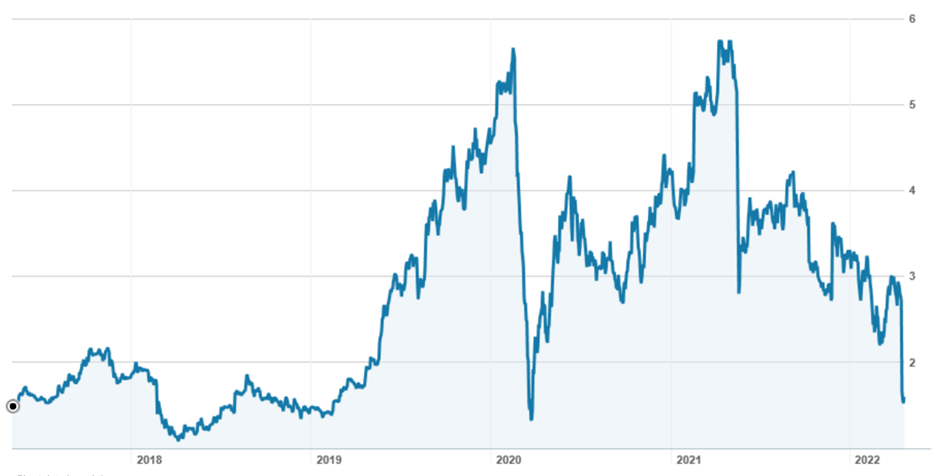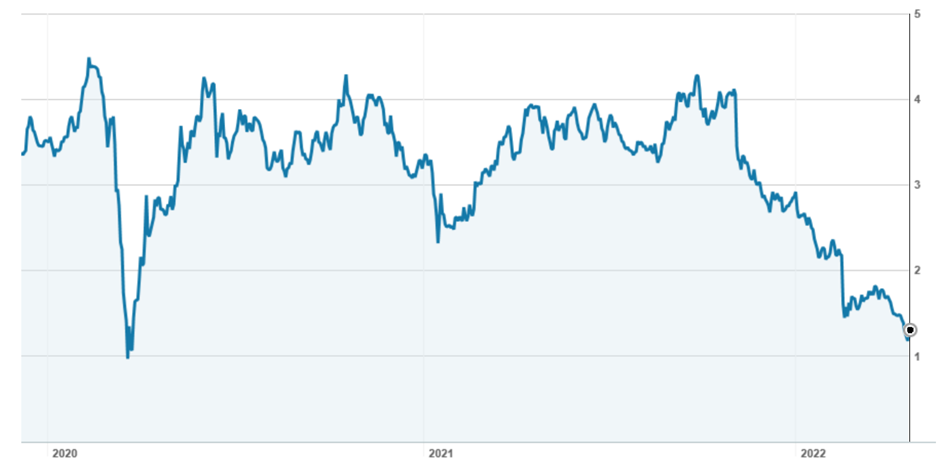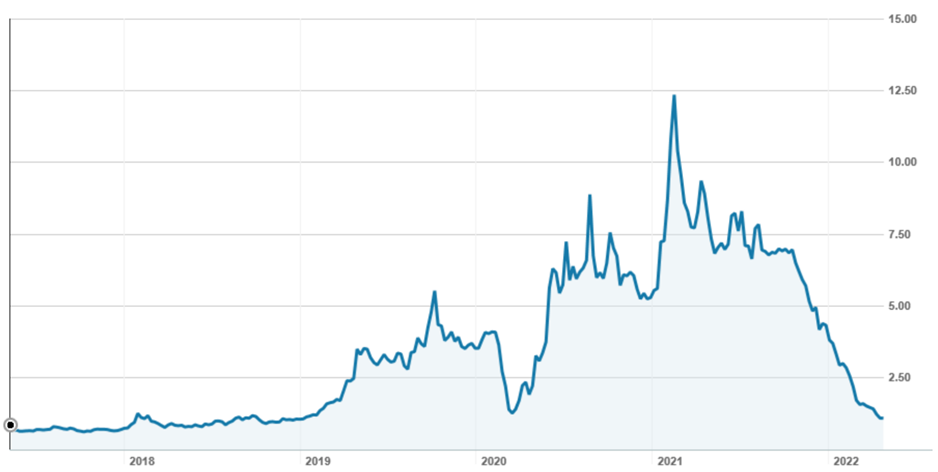Security Alert: Scam Text Messages
We’re aware that some nabtrade clients have received text messages claiming to be from [nabtrade securities], asking them to click a link to remove restrictions on their nabtrade account. Please be aware this is likely a scam. Do not click on any links in these messages. nabtrade will never ask you to click on a link via a text message to verify or unlock your account.
Payments companies have been smashed on the ASX – are they a buy?
Payments has been a hugely popular sector on the ASX in recent years, as payment tech firm EML Payments and the ASX’s cohort of buy-now, pay-later (BNPL) players became darlings of infatuated investors.
The poster child for this was, of course, Afterpay, which rocketed from an initial public offering (IPO) price of $1.00 in April 2016 to levels above $158 less than five years later, to the Top 10 of the ASX.
The balloon started to lose air in 2021, as the big BNPL players’ costs blew out and their bad debts rose.
In August 2021, Afterpay announced that it would be taken over by US fintech giant Square, Inc. (now known as Block, Inc.), and the shares left the ASX in January 2022, replaced by CHESS Depositary Interests (CDIs) in Block, which trade on the ASX under the code SQ2, one-for-one with Block’s US shares.
The CDIs began trading on the ASX in January at a price of $176.08. They peaked at $194.36 in March, before falling to $116.05 in February. But SQ2 has recovered somewhat, to $140.31.
Afterpay’s major rival, Zip Co (ZIP), was hammered by the BNPL bust, falling from a record high of $12.35 in February 2021, after it acquired the US-based BNPL business Quadpay to grow its footprint in the lucrative American market, to its present levels of $1.06. That 91.4% tumble tells you all you need to know about the market’s changing view of BNPL.
EML Payments (EML) is a bit different – it is not a BNPL player, having built its business on payment technology solutions for payouts, gift incentives and rewards; the $423 million acquisition of Irish firm, Prepaid Financial Services, in November 2019, changed the game for the company, opening-up exposure in providing prepaid payments and digital banking capabilities and other flexible software solutions to financial and non-financial institutions. EML is particularly well-suited to the rise of open banking – a global regulatory change that gives consumers the power to securely share their selected banking data with accredited third parties.
However, the Irish connection has caused plenty of pain for EML.
EML Payments (EML)

5 year stock chart of EML Payments (EML).
Source: nabtrade
In May 2021, the Central Bank of Ireland raised concerns over anti-money laundering (AML) compliance in EML’s systems – that caused a 41% fall in the share price, from $5.71 to $3.37. By September 2021 EML had climbed back above $4, but the CBI blindsided the company again, raising fresh concerns over its growth plan and regulatory directions: from $4.19, EML started a slide that took it to its present level of $1.55. The market is gun-shy on the prospect of similar regulatory action in other jurisdictions.
Payment processor Tyro Payments (TYR), which provides payment solutions, credit, debit, EFTPOS services and business lending services, is also not a BNPL player, but it shares have been trending downward since November 2021, from $4.28 to $1.25 – a 71% slide. First-half results in late February disappointed investors, as operating expenses increased.
Tyro Payments (TYR)

5 year stock chart of Tyro Payments (TYR).
Source: nabtrade
So, is it time to be a contrarian investor in the payments space – with most of the major players on the nose?
I think so – with a fair bit of caution. In particular, I like the prospects of Block, Inc. (SQ2), EML Payments (EML) and Tyro Payments (TYR).
With the BNPLs, you would be investing in an industry that has a huge runway for growth. While BNPL as a part of the payments world has grown rapidly, it still only accounted for 2% of global eCommerce in 2020, according to global payment processing company Worldpay.
According to Precedent Research’s Buy Now, Pay Later Market Size, Share, Trends Report 2022–2030, BNPL was a US$87.2 billion global market in 2020: it grew to US$125.6 billion in 2021, but by 2030 Precedent Research estimates that it will reach US$3.3 trillion. That heavily implies that BNPL will have a permanent role in the everyday lives of customers around the world.
Let’s look at Block, Inc. (SQ2). At $140.31 on the ASX, that corresponds to US$99.62. SQ – the New York Stock Exchange (NYSE)-listed headstock – closed at US99.54 on Friday.
Afterpay’s results for the year to December 31 – released by Block in April – were not great, with costs surging by 65% and bad debts rising 70%. The total provisioning number for bad debts jumped from $99 million to $151 million, but the company said the volume of debts actually written off had come down, from $129 million in the prior period to $125 million. Afterpay’s total income rose 55% to $645 million, but its loss widened to $345 million after an expected bigger weighting of US sales prompted its cost of sales to rise. Late fees and other income more than doubled (up 124%) to $79 million, implying that more customers are struggling to repay their debts.
Block’s justification for buying Afterpay remains intact – it wants to use the Afterpay acquisition to build a market with existing merchants for its Cash App, a consumer financial app with 44 million monthly users in the United States, and cross-sell to Afterpay’s customers the rest of the financial products in the Cash App ecosystem. But very quietly, in February Block revised Afterpay’s own business growth expectations of 70%, to 25%–30%.
US analysts have, on consensus, a very positive view of Block, Inc. – as collated by Wallmine, the analysts’ consensus 12-month price target on SQ is $198.00. Exchange-rate fluctuations will play a role in the price of SQ2 – but a doubling of the US stock price would more than offset that if borne-out.
While Zip Co (ASX: ZIP) has a thoroughly chastened share price, it has a “refreshed strategy” to show investors profitability, in the wake of the February acquisition of fellow BNPL player Sezzle. Incorporating the US-focused Sezzle should help Zip with the existential challenge for the BNPL players, to achieve the required scale and cut costs in order to show a profit.
Zip Co (Z1P)

5 year stock chart of Zip Co (Z1P)
Source: nabtrade
Zip Co says the Sezzle buy will help it achieve faster profitability, pledging to get to positive cash earnings by the 2024 financial year, as a larger user base makes the payments platform more attractive to US retailers.
Broker Morgans thinks that is a tall order: it does not see positive EBITDA, pre-tax profit or net profit in FY24 – and has slashed its target price from $3.94 to $1.26, with the shares trading at $1.06.
Stock Doctor/Thomson Reuters has a consensus target price for ZIP of $1.45 – with eight analysts contributing – which is a bit more optimistic than Morgans’ alone. ZIP could reward some judicious bottom-fishing, but the euphoria of 2020-2021 is long gone, and caution now reigns.
At $1.59, EML Payments has an analysts’ consensus price target of $2.30 at Stock Doctor/Thomson Reuters, with nine analysts contributing. Brokers are still wary of the CBI’s regulatory challenge, and its effect on the growth prospects and the quality of earnings. The market slashed the value of EML by more than 38% on April 26, on the back of the release of the company’s third-quarter result and the accompanying cuts to full-year revenue and profit guidance, but it’s interesting that both UBS and Macquarie have assessed this result and have “buy” and “outperform” ratings respectively on EML: UBS has a target price of $2.30, while Macquarie has a very bullish $3.45 (cut from $3.80). Investors who like to see a bit of optimism from brokers will take some comfort from that.
At $1.25, Tyro Payments also looks very attractive. Broker UBS is quite positive on the stock, saying the business is on the verge of margin expansion and positive free cashflow – which gives it some belief that Tyro can achieve scalability and operating leverage.
UBS estimates that Tyro Payments is trading at a discount of about 25% compared to its peer group of comparable payments/technology stocks. Tyro Payments holds a 4.4% share of the $670 billion total card payments market in Australia and UBS estimates that it can reach a 7.7% share by FY26. The most positive broker on Tyro is Ord Minnett, with a price target of $3.00. FN Arena arrives at a consensus price target of $2.97, while Stock Doctor/Thomson Reuters is not as optimistic, with a consensus target price for TYR of $2.15 – still alluring at the current price.
All prices and analysis at 2 May 2022. This information was produced by Switzer Financial Group Pty Ltd (ABN 24 112 294 649), which is an Australian Financial Services Licensee (Licence No. 286 531). This material is intended to provide general advice only. It has been prepared without having regard to or taking into account any particular investor’s objectives, financial situation and/or needs. All investors should therefore consider the appropriateness of the advice, in light of their own objectives, financial situation and/or needs, before acting on the advice. This article does not reflect the views of WealthHub Securities Limited.
